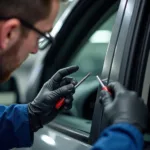Dealing with a ripped car seat can be frustrating, affecting both the aesthetics and value of your vehicle. Fortunately, you don’t always need a professional to fix it. This guide provides a comprehensive walkthrough on how to repair a rip in your car seat, covering everything from simple DIY fixes to more advanced repairs.
Assessing the Damage: What’s the Best Approach?
Before diving into the repair process, it’s crucial to assess the severity of the rip.
- Small Tears and Punctures: These can often be addressed using simple DIY repair kits that involve patching the damaged area.
- Larger Rips and Tears: These might require more advanced techniques, such as sewing or patching with a larger piece of material.
- Rips on Seams: Repairing ripped seams often necessitates sewing skills or professional intervention for optimal results.
DIY Repair Kits: A Quick Fix for Minor Damages
DIY car seat repair kits are readily available online and at auto parts stores. They are typically cost-effective and suitable for repairing small rips, tears, and burns.
Here’s a step-by-step guide on using a DIY repair kit:
- Clean the Area: Thoroughly clean the ripped area using a mild cleaner and a soft cloth. Allow the area to dry completely.
- Prepare the Patch: If your kit comes with a backing fabric, cut it to the appropriate size, ensuring it’s slightly larger than the rip itself.
- Apply the Adhesive: Apply the adhesive provided in the kit to the underside of the rip or the backing fabric, following the manufacturer’s instructions.
- Position the Patch (If Applicable): Carefully place the patch over the rip, ensuring it aligns correctly and lies flat.
- Apply Pressure: Use a roller or your fingers to apply even pressure to the patch, ensuring proper adhesion.
- Apply Filler (If Necessary): Some kits include a filler compound for a seamless finish. Apply it to the repaired area, blending it outward for a smooth transition.
- Let it Dry: Allow the adhesive and filler to dry completely according to the manufacturer’s recommendations.
Dealing with Larger Tears: Sewing or Patching?
Larger tears might require more advanced methods like sewing or using a larger patch.
Sewing: If you have basic sewing skills, you can use a heavy-duty needle and thread that matches the color of your car seat upholstery.
- Pro Tip: Use a curved needle for easier access to tight spaces.
Patching: For patching, you’ll need a piece of matching upholstery fabric slightly larger than the tear. Secure it using fabric glue designed for automotive upholstery or a strong adhesive suitable for the material.
When to Call a Professional
While DIY solutions can be effective for minor rips, certain situations call for professional help:
- Extensive Damage: If the rip is significant, involves multiple layers of fabric, or affects the structural integrity of the seat, seeking professional help is recommended.
- Airbag Deployment: Never attempt to repair a car seat that has been affected by airbag deployment. Contact a qualified technician for assistance.
- Heated or Cooled Seats: These seats involve intricate wiring systems. It’s best to consult a professional to avoid damaging these components during repair.
Ripped Leather Car Seat? Special Considerations
Leather car seats require a different approach compared to fabric upholstery. Specialized leather repair kits are available, typically featuring a color-matching compound, an applicator, and a texture pad.
- Expert Insight: “Using the right color-matching compound is crucial for achieving a seamless repair on leather seats,” says John Miller, an automotive upholstery specialist with over 20 years of experience. “Take your time to find the perfect match for a professional-looking result.”
Preventing Future Rips: Tips for Maintaining Your Car Seats
- Regular Cleaning: Regularly vacuum and clean your car seats to prevent dirt and debris from causing abrasions.
- Seat Covers: Using seat covers, especially if you frequently transport pets or cargo, can provide an extra layer of protection.
- Avoid Sharp Objects: Be mindful of sharp objects like keys, tools, and even belt buckles that could potentially puncture or tear your seats.
Conclusion
Repairing a rip in your car seat can be a manageable task, often saving you the cost of professional services. By assessing the damage, using the right techniques, and following the provided tips, you can restore your car seat’s appearance and extend its lifespan. Remember, regular maintenance and proactive care can go a long way in preventing future rips and tears, keeping your car interior looking its best.


